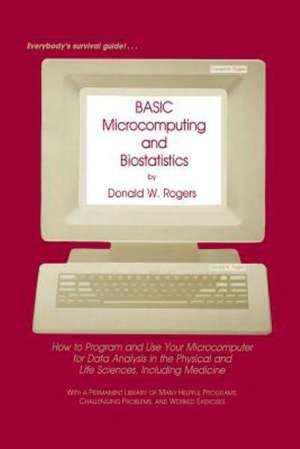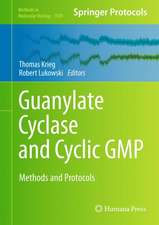BASIC Microcomputing and Biostatistics: How to Program and Use Your Microcomputer for Data Analysis in the Physical and Life Sciences, Including Medicine
Autor Donald W. Rogersen Limba Engleză Paperback – 21 oct 2011
| Toate formatele și edițiile | Preț | Express |
|---|---|---|
| Paperback (1) | 634.64 lei 6-8 săpt. | |
| Humana Press Inc. – 21 oct 2011 | 634.64 lei 6-8 săpt. | |
| Hardback (1) | 646.43 lei 6-8 săpt. | |
| Humana Press Inc. – 12 sep 1983 | 646.43 lei 6-8 săpt. |
Preț: 634.64 lei
Preț vechi: 746.63 lei
-15% Nou
Puncte Express: 952
Preț estimativ în valută:
121.45€ • 126.33$ • 100.27£
121.45€ • 126.33$ • 100.27£
Carte tipărită la comandă
Livrare economică 14-28 aprilie
Preluare comenzi: 021 569.72.76
Specificații
ISBN-13: 9781461297765
ISBN-10: 1461297761
Pagini: 292
Ilustrații: XII, 276 p.
Dimensiuni: 155 x 235 x 15 mm
Greutate: 0.41 kg
Ediția:1983
Editura: Humana Press Inc.
Colecția Humana
Locul publicării:Totowa, NJ, United States
ISBN-10: 1461297761
Pagini: 292
Ilustrații: XII, 276 p.
Dimensiuni: 155 x 235 x 15 mm
Greutate: 0.41 kg
Ediția:1983
Editura: Humana Press Inc.
Colecția Humana
Locul publicării:Totowa, NJ, United States
Public țintă
ResearchCuprins
1. Introduction to the Computer.- Computer Memory.- Data Processing.- Control.- Kinds of Computers.- Batch Processing and Time Sharing.- When Not to Use the Computer.- Problems.- 2. Understanding Experimental Error and Averages.- Significant Figures.- Sources of Errors.- Truncation Errors.- Propagation of Errors.- Euler’s Theorem and Variations.- Geometrical Interpretation of Euler’s Theorem.- Measures of Central Tendency.- The Means of Means.- Problems.- 3. Understanding Experimental Data Dispersion.- The Average Deviation.- The Mean Deviation Independent of the Sign.- Population Parameters and Sample Statistics.- The Standard Deviation.- Relative Standard Deviation.- Grouped Data and Frequency Distributions.- Cumulative Frequency Distributions.- Application: Dose-Response Curve.- Frequency Grouping and Pictorial Representation of Continuous Data.- Quartiles and Percentiles.- Skewness and Kurtosis.- Problems.- 4. Understanding Probability.- Simultaneous and Equally Acceptable Probabilities.- Application: Heredity.- The Urn Problem: Dependent Probabilities.- Conditional Probabilities.- Bayes’ Theorem.- Application of Bayes’ Theorem: Diagnosis.- Permutations.- Combinations.- The Binomial Coefficient.- Problems.- 5. Determining Probability Distributions.- Tree Diagrams.- Application: Heredity.- Modal and Mean Scores.- The Binomial Distribution.- Effect of p on the Binomial Distribution.- Mean Occurrences for Data Groups of N.- Application: Evaluation of a New Treatment.- Problems.- 6. Using the Poisson Distribution.- Application: Disintegration of Radioactive Nuclei.- Mean, Variance, and Standard Deviation for the Poisson Distribution.- Computer Graphics.- Problems.- 7. Using the Normal Distribution.- Relative Areas by Computer Graphics.- Normalization of theGaussian Distribution.- The Mean, Variance, and Standard Deviation of the Gaussian Distribution.- The Standard Normal Deviate, z.- Computer Integration.- Tabulated Areas Under the Normal Curve.- The Most Common Areas and Limits on z.- One- and Two-Tailed Tests.- Problems.- 8. Determining Probabilities: How to Apply the Chi Square Test and the Student’s t-Test.- Chi Square Detection of a Biased Coin.- Degrees of Freedom.- The Central Limit Theorem.- Situations in Which the Population Mean Is Known But Not Its Standard Deviation.- Determination of Confidence Limits When No Population Parameters Are Known.- Confidence Limits.- The Difference Between Means.- Problems.- 9. Finding Linear Functions: The Principle of Least Squares.- Linear Functions.- Least Squares Treatment of Linear Functions Passing Through the Origin.- The Correlation Coefficient.- Applications.- Least Squares with Two Minimization Parameters.- Simultaneous Equations.- Solution of Simultaneous Equations by Cramer’s Rule.- The Determinant of the Coefficients.- Cramer’s Rule.- Solution of the Normal Equations for Linear Curve Fitting by Cramer’s Rule.- Problems.- 10. Fitting Nonlinear Curves.- Boyle’s Law.- Exponential Decay.- Second-Order Reaction Kinetics.- Enzyme-Catalyzed Reactions.- Unlimited Population Growth.- Limited Population Growth.- Nearly Linear Functions.- Problems.- 11. Solving Simultaneous Equations.- Simultaneous Equations in Matrix Form.- Matrix Algebra.- Simultaneous Equations by Matrix Inversion.- Simultaneous Analysis.- Multiple Regression.- Least Squares Treatment of Multiple Regression.- Problems.- Answers to Problems.
















